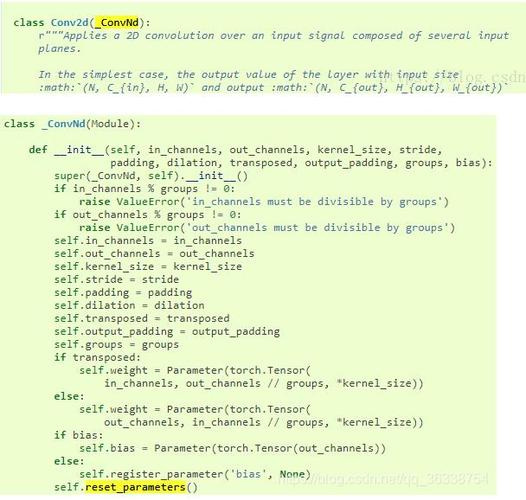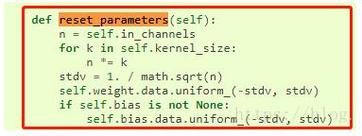可参考:torch.nn.init - 云+社区 - 腾讯云

(图片来源网络,侵删)
一. torch.nn.init.constant_(tensor, val)
1. 作用:
常数分布: 用值val填充向量。
2. 参数:
- tensor – an n-dimensional torch.Tensor
- val – the value to fill the tensor with
3. 实例:
import torch form torch from nn w = torch.empty(3, 5) print(w) print(nn.init.constant_(w, 0.3)) ------------------------------------- tensor([[6.4069e+02, 2.7489e+20, 1.5444e+25, 1.6217e-19, 7.0062e+22], [1.6795e+08, 4.7423e+30, 4.7393e+30, 9.5461e-01, 4.4377e+27], [1.7975e+19, 4.6894e+27, 7.9463e+08, 3.2604e-12, 2.6209e+20]]) tensor([[0.3000, 0.3000, 0.3000, 0.3000, 0.3000], [0.3000, 0.3000, 0.3000, 0.3000, 0.3000], [0.3000, 0.3000, 0.3000, 0.3000, 0.3000]])二. torch.nn.init.normal_(tensor, mean=0, std=1)
1. 作用:
正态分布:从给定均值和标准差的正态分布N(mean, std)中生成值,填充输入的张量或变量。
 (图片来源网络,侵删)
(图片来源网络,侵删)2. 参数:
- tensor – n维的torch.Tensor
- mean – 正态分布的均值
- std – 正态分布的标准差
3. 实例:
import torch from torch import nn w = torch.empty(3, 5) print(w) print(torch.nn.init.normal_(w)) ---------------------------------------------- tensor([[9.5461e-01, 4.4377e+27, 1.7975e+19, 4.6894e+27, 7.9463e+08], [3.2604e-12, 2.6209e+20, 4.1641e+12, 1.9434e-19, 3.0881e+29], [6.3828e+28, 1.4603e-19, 7.7179e+28, 7.7591e+26, 3.0357e+32]]) tensor([[-1.1406, -0.1720, -1.4460, 0.5305, -0.0854], [ 0.8992, 0.3495, -0.8262, -1.4641, -0.6426], [ 0.7404, 0.7124, -0.3902, 0.0625, 0.6256]])三. torch.nn.init.uniform_(tensor, a=0.0, b=1.0)
1.作用:
均匀分布: 从均匀分布N(a,b)中生成值,填充输入的张量或变量。
2. 参数:
- tensor – n 维的torch.Tensor
- a – 均匀分布的下界
- b – 均匀分布的上界
3. 实例:
import torch from torch import nn w = torch.empty(3, 5) print(w) print(nn.init.uniform_(w)) ----------------------------------------------- tensor([[9.5461e-01, 4.4377e+27, 1.7975e+19, 4.6894e+27, 7.9463e+08], [3.2604e-12, 2.6209e+20, 4.1641e+12, 1.9434e-19, 3.0881e+29], [6.3828e+28, 1.4603e-19, 7.7179e+28, 7.7591e+26, 3.0357e+32]]) tensor([[0.6653, 0.9605, 0.2208, 0.0140, 0.9672], [0.4201, 0.5819, 0.8383, 0.4334, 0.0673], [0.1246, 0.4066, 0.3413, 0.1231, 0.0463]])四. torch.nn.init.ones_(tensor)
1.作用:
全1分布:用标量值 1 填充输入张量。
2. 参数:
- tensor – n 维的torch.Tensor
3. 实例:
import torch from torch import nn w = torch.empty(3, 5) print(w) print(nn.init.ones_(w)) --------------------------------------- tensor([[9.5461e-01, 4.4377e+27, 1.7975e+19, 4.6894e+27, 7.9463e+08], [3.2604e-12, 2.6209e+20, 4.1641e+12, 1.9434e-19, 3.0881e+29], [6.3828e+28, 1.4603e-19, 7.7179e+28, 7.7591e+26, 3.0357e+32]]) tensor([[1., 1., 1., 1., 1.], [1., 1., 1., 1., 1.], [1., 1., 1., 1., 1.]])五. torch.nn.init.zeros_(tensor)
1.作用:
全0分布:用全0填充张量。
2. 参数:
- tensor – n 维的torch.Tensor
3. 实例:
import torch from torch import nn w = torch.empty(3, 5) print(w) print(nn.init.zeros_(w)) ------------------------------------------------- tensor([[-4.2990e-27, 4.5701e-41, -4.2990e-27, 4.5701e-41, nan], [ 4.5699e-41, 7.6194e+31, 1.5564e+28, 4.7984e+30, 6.2121e+22], [ 1.8370e+25, 1.4603e-19, 6.4069e+02, 2.7489e+20, 1.5444e+25]]) tensor([[0., 0., 0., 0., 0.], [0., 0., 0., 0., 0.], [0., 0., 0., 0., 0.]])六. torch.nn.init.eye_(tensor)
1.作用:
对角分布:用单位矩阵来填充2维输入张量或变量。
2. 参数:
- tensor – 2维的torch.Tensor 或 autograd.Variable
3. 实例:
import torch from torch import nn w = torch.empty(3, 5) print(w) print(nn.init.eye_(w)) ------------------------------------------- tensor([[9.5461e-01, 4.4377e+27, 1.7975e+19, 4.6894e+27, 7.9463e+08], [3.2604e-12, 2.6209e+20, 4.1641e+12, 1.9434e-19, 3.0881e+29], [6.3828e+28, 1.4603e-19, 7.7179e+28, 7.7591e+26, 3.0357e+32]]) tensor([[1., 0., 0., 0., 0.], [0., 1., 0., 0., 0.], [0., 0., 1., 0., 0.]])七. torch.nn.init.dirac_(tensor, groups=1)
1.作用:
dirac分布:用Dirac δ函数来填充{3, 4, 5}维输入张量或变量。在卷积层尽可能多的保存输入通道特性。
2. 参数:
- tensor – {3, 4, 5}维的torch.Tensor 或 autograd.Variable
3. 实例:
import torch from torch import nn w = torch.empty(3, 16, 5, 5) print(w.shape) print(nn.init.dirac_(w).shape) z = torch.empty(3, 24, 5, 5) print(z.shape) print(nn.init.dirac_(z, 3).shape) --------------------------------------------- torch.Size([3, 16, 5, 5]) torch.Size([3, 16, 5, 5]) torch.Size([3, 24, 5, 5]) torch.Size([3, 24, 5, 5])
八. torch.nn.init.xavier_uniform_(tensor, gain=1.0)
1. 作用:
xavier_uniform分布:用一个均匀分布生成值,填充输入的张量或变量。
2. 参数:
- tensor – n维的torch.Tensor
- gain – 可选的缩放因子
3.实例:
import torch from torch import nn w = torch.empty(3, 5) print(w) print(nn.init.xavier_uniform_(w, gain=nn.init.calculate_gain('relu'))) ---------------------------------------------------------- tensor([[6.4069e+02, 2.7489e+20, 1.5444e+25, 1.6217e-19, 7.0062e+22], [1.6795e+08, 4.7423e+30, 4.7393e+30, 9.5461e-01, 4.4377e+27], [1.7975e+19, 4.6894e+27, 7.9463e+08, 3.2604e-12, 2.6209e+20]]) tensor([[-0.9562, -0.6834, 0.7449, -0.2484, -0.7638], [-1.0150, -0.2982, -0.2133, -1.1132, -1.0273], [ 0.5228, 0.9122, -0.5077, -0.2911, 0.1625]])九. torch.nn.init.xavier_normal_(tensor, gain=1.0)
1. 作用:
xavier_normal 分布:用一个正态分布生成值,填充输入的张量或变量。
2. 参数:
- tensor – n维的torch.Tensor
- gain – 可选的缩放因子
3. 实例:
import torch from torch import nn w = torch.empty(3, 5) print(w) print(nn.init.xavier_normal_(w)) -------------------------------------------- tensor([[4.7984e+30, 6.2121e+22, 1.8370e+25, 1.4603e-19, 6.4069e+02], [2.7489e+20, 1.5444e+25, 1.6217e-19, 7.0062e+22, 1.6795e+08], [4.7423e+30, 4.7393e+30, 9.5461e-01, 4.4377e+27, 1.7975e+19]]) tensor([[ 0.3654, 0.4767, 0.1407, -0.4990, 0.2799], [ 0.0545, 0.5941, -0.3611, 0.5469, 0.0781], [-0.0393, 0.1817, -0.0407, -0.2593, -0.2736]])十. torch.nn.init.kaiming_uniform_(tensor, a=0, mode='fan_in', nonlinearity='leaky_relu')
1. 作用:
kaiming_uniform 分布:用一个均匀分布生成值,填充输入的张量或变量。
2. 参数:
- tensor – n维的torch.Tensor或autograd.Variable;
- a – 这层之后使用的rectifier的斜率系数(ReLU的默认值为0);
- mode – 可以为“fan_in”(默认)或 “fan_out”;
- “fan_in” – 保留前向传播时权值方差的量级;
- “fan_out” – 保留反向传播时的量级;
- nonlinearity=‘leaky_relu’ – 非线性函数 建议“relu”或“leaky_relu”(默认值)使用。
3. 实例:
import torch from torch import nn w = torch.empty(3, 5) print(w) print(nn.init.kaiming_uniform_(w, mode='fan_in', nonlinearity='relu')) ------------------------------------------------- tensor([[9.5461e-01, 4.4377e+27, 1.7975e+19, 4.6894e+27, 7.9463e+08], [3.2604e-12, 2.6209e+20, 4.1641e+12, 1.9434e-19, 3.0881e+29], [6.3828e+28, 1.4603e-19, 7.7179e+28, 7.7591e+26, 3.0357e+32]]) tensor([[ 0.6771, -0.7587, 0.6915, -0.7163, 0.0840], [-1.0694, -0.4790, -0.4019, -0.8439, 0.5794], [-0.9363, -0.0655, -0.0506, -0.1419, 0.5395]])十一. torch.nn.init.kaiming_normal_(tensor, a=0, mode='fan_in', nonlinearity='leaky_relu')
1. 作用:
kaiming_normal 分布:用一个正态分布生成值,填充输入的张量或变量。
2. 参数:
- tensor – n维的torch.Tensor或autograd.Variable;
- a – 这层之后使用的rectifier的斜率系数(ReLU的默认值为0);
- mode – 可以为“fan_in”(默认)或 “fan_out”fan_in保留前向传播时权值方差的量级fan_out保留反向传播时的量级。
3. 实例:
import torch from torch import nn w = torch.empty(3, 5) print(w) print(nn.init.kaiming_normal_(w, mode='fan_out', nonlinearity='relu')) ------------------------------------------------- tensor([[9.5461e-01, 4.4377e+27, 1.7975e+19, 4.6894e+27, 7.9463e+08], [3.2604e-12, 2.6209e+20, 4.1641e+12, 1.9434e-19, 3.0881e+29], [6.3828e+28, 1.4603e-19, 7.7179e+28, 7.7591e+26, 3.0357e+32]]) tensor([[-0.2421, 1.3102, -0.0506, 0.5099, -0.1017], [-1.2707, -0.9636, -0.4539, 1.1167, 0.6717], [ 0.1898, 0.6261, -1.1114, -0.4440, 0.5798]])十二. torch.nn.init.orthogonal_(tensor, gain=1)
1. 作用:
正交矩阵:用一个(半)正交矩阵填充输入张量。
2. 参数:
- tensor– 一个n维的tensor,其中 n≥2
- gain– 可选比例系数
3. 实例:
import torch from torch import nn w = torch.empty(3, 5) print(w) print(nn.init.orthogonal_(w)) ------------------------------------------------ tensor([[9.5461e-01, 4.4377e+27, 1.7975e+19, 4.6894e+27, 7.9463e+08], [3.2604e-12, 2.6209e+20, 4.1641e+12, 1.9434e-19, 3.0881e+29], [6.3828e+28, 1.4603e-19, 7.7179e+28, 7.7591e+26, 3.0357e+32]]) tensor([[-0.2146, -0.8764, -0.3447, -0.1060, 0.2363], [-0.1957, 0.2711, 0.0974, -0.6438, 0.6813], [ 0.6258, -0.3716, 0.6203, -0.2903, -0.0353]]十二. torch.nn.init.sparse_(tensor, sparsity, std=0.01)
1. 作用:
稀疏矩阵:将2D输入张量填充为稀疏矩阵,其中非零元素将从正态分布N ( 0 , 0.01 ) N(0,0.01)N(0,0.01)中提取。
2. 参数:
- tensor– 一个n维的torch.tensor张量
- sparsity– 每一列中元素的比例设置为零
- std– 用于产生非零值的正态分布的标准差
3. 实例:
import torch from torch import nn w = torch.empty(3, 5) print(w) print(nn.init.sparse_(w, sparsity=0.1)) ------------------------------------------ tensor([[9.5461e-01, 4.4377e+27, 1.7975e+19, 4.6894e+27, 7.9463e+08], [3.2604e-12, 2.6209e+20, 4.1641e+12, 1.9434e-19, 3.0881e+29], [6.3828e+28, 1.4603e-19, 7.7179e+28, 7.7591e+26, 3.0357e+32]]) tensor([[ 0.0112, 0.0000, -0.0055, 0.0000, 0.0000], [ 0.0026, -0.0009, 0.0000, -0.0044, -0.0012], [ 0.0000, 0.0176, 0.0022, -0.0037, -0.0035]])
- tensor – {3, 4, 5}维的torch.Tensor 或 autograd.Variable
- tensor – 2维的torch.Tensor 或 autograd.Variable
- tensor – n 维的torch.Tensor
- tensor – n 维的torch.Tensor









